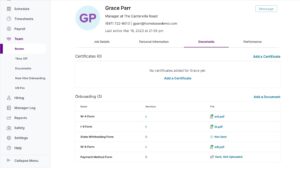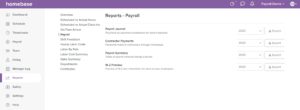Small businesses have a lot of expenses that should stay on top. There are team salaries, rent, utilities, vendors, and everything else in between. Because of this, your own salary may be on the backburner.
However, it is important that owners pay themselves appropriately and factor that cost into their budget. Small businesses often have very thin profit margins, so if you don’t pay attention to your monthly salary and how it affects your cash flow, you risk problems later.
To help you avoid problems, we’ve created this guide on how to pay as a business owner. We’ll walk you through all the necessary steps and show you how Homebase can help you along the way. Let’s get started.
Step #1: Find out your business’s financials
Your main concern is probably balancing earning a living wage with not cutting too deeply into the interests of the business. Therefore, it is important to check your financial situation and see how much you can afford to pay yourself before making a deposit.
A statement provides the best picture of your business’s overall financial position.look at you Profit and loss statement and find you gross profit See how much extra cash you generated during the last year.
Then calculate how much you need to leave for potential expenses, emergencies, and business growth. You never know when you’ll need the money to fix a leaky roof or replace a broken coffee machine.
You can pay yourself from the remaining profit. The exact amount will depend on the specifics of your business, but to give you a rough idea, this will range from: $30,000 $130,000 per year, $69,000 average.
Step #2: Decide whether to pay yourself or draw
managers must also decide how Pay yourself, either with a salary or a draw. There is no correct answer here — The best way to pay yourself as a business owner. It depends on your needs and preferences.
Ann Owner’s Draw You can transfer funds from your business account at any time. If desired, this can be as regular as a standard salary. Here are the main pros and cons:
- Pros: You can easily change the amount depending on the financial situation of your business.
- Pros: You can pay immediately.
- Cons: Extra paperwork and stress as you are responsible for arranging tax withholding, social security, and medical expenses yourself.
Paying yourself means adding yourself to the salary and getting paid monthly just like the rest of your staff. for example, home based payroll tool Owners can set themselves up as W-2 employees and be paid that way. This is a less flexible method than a lottery, but you can still raise or lower your salary if economic conditions change. Here are the pros and cons:
- Pros: Salary is a better indicator of overall business health. If your payroll system sees you (the owner) as one of the regular employee girlfriends of your business and flags you as unable to afford to pay, then you have a cash flow problem.
- Pros: Treating your salary as an expense saves you taxes.
- Cons: If you are unsure of your cash flow, you are more likely to end up underpaying or overpaying.

Step #3: Set up your salary schedule
Deciding when to pay yourself as an owner is just as important as the amount.if you make the wrong choice payslipcan cause cash flow problems, such as not leaving enough money to pay your utility bills.
As for the drawing, it is always convenient and you can receive it whenever you have funds available in your business account. You need to make sure there are no upcoming spending or low income hiatus.
For salaries, deciding when to pay is more complicated. If you’re adding yourself to your business’s payroll, you’ll be receiving checks at the same time as your staff. In other words, considering their needs, Stay compliant Comply with relevant payroll laws.
Start by checking your state and industry payday requirements. Ministry of Labor (DOL) website. For example, Maine requires employers to pay their employees at least every 16 days of her.If you need help navigating the laws in your state, visit Homebase human resources Features give you access to experienced professionals who can guide you through the process. Plus, get alerts when local payday laws change.
Then consider which pay schedule works best for your employees and your business. Usual options are:
- every week
- biweekly
- semi-monthly
- monthly
Once you’ve ruled out options prohibited by local regulations, choose a schedule based on your cash flow cycle and the types of employees you’re hiring. For example, weekly payroll may be suitable for hourly workers who work irregular hours. That way, after working overtime, you won’t have to wait weeks to receive your extra cash. When in doubt, ask the team for their preferences and make decisions based on their feedback.
Step #4: Understand the Tax Implications of Paying Yourself
If you have a lot of paperwork to remember for your employees, wouldn’t it be even worse for your owners? there is no.
We don’t withhold earnings if you’re paying yourself with a draw. Instead, file your tax estimates quarterly.Experts recommend saving 30-40% Make sure you have enough to cover your bill.
But for salaries, I report my income along with the rest of the team. You are also required to complete the same annual forms as employees, such as W-2s and tax returns. Download tax forms from Internal Revenue Service (IRS) treat them like your employees social security (SSA) website.
If you don’t have the budget to handle all this paperwork or hire an accountant, consider: Salary Software like Homebase. Our platform can run payroll for you and automatically report taxes for everyone, including you.

Step #5: Pay Yourself and Maintain Healthy Cash Flow
Once you’ve paid yourself for the first time and turned in all your paperwork, it’s easy to forget how your salary contributes to your business expenses. However, there are a few more steps you need to follow to stick to your budget and stay profitable.
- Don’t underpay yourself or work for free. You’re a business owner and another member of your team. If you can’t pay all your employees (including yourself), you’ll need to solve your cash flow problem. Working without pay is only a temporary solution.
- Make sure you can invest in your business. Your company must adapt and grow to remain competitive. So prioritize increased funding over a pay raise as the investment is likely to pay off in the long run.
- Don’t put pressure on your finances: Small business earnings can be highly volatile. Be careful not to give yourself a pay rise after the recent surge in profits if you may need that money for future recessions.
- Review salaries regularly. As your business changes, you may find that the way you pay for yourself no longer works. As such, we recommend that you continue to monitor the percentage of profit you are earning and consider whether your payment method is still working.
- Compare your salary to your team’s wage: Your salary can be a useful barometer of your staff’s wages. Basically, if you find yourself getting paid a lot extra as a result of your profits, consider whether you should give your team members a raise as well. If so, staff may look elsewhere, so paying a competitive rate is important for retention.
Pay easily with Homebase
learn How to pay yourself as a small business owner It may not be at the top of your priority list, but it can be stress-free later. Give yourself a fair salary, stay on top of your finances, and avoid cash flow problems.
Home Base helps you overcome obstacles and find pitfalls in adding yourself to the payroll. our Human Resources and Compliance Using our tools ensures that you are not violating any state or federal laws when setting up payments.Then you can use Salary Pay yourself and file your taxes. And you can store all these documents using a cloud system, making them safe and easy to access online. That way, you can pay a reasonable salary while maintaining healthy cash flow to your business.

